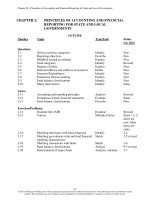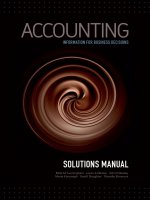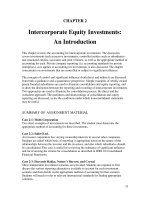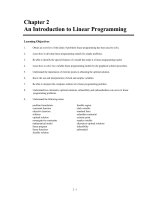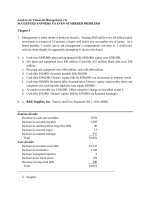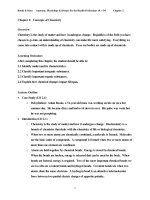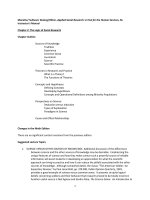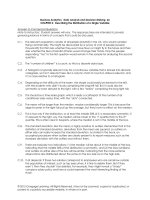Test bank and solution of analysis for FInancial management 11e (1)
Bạn đang xem bản rút gọn của tài liệu. Xem và tải ngay bản đầy đủ của tài liệu tại đây (123.42 KB, 3 trang )
Analysis for Financial Management, 11e
SUGGESTED ANSWERS TO EVEN-NUMBERED PROBLEMS
Chapter 1
2. Management is either dumb or thinks its board is. Earning $100 million on a $4 billion equity
investment is a return of 2.5 percent, a figure well below any reasonable cost of equity. As a
board member, I would vote to cut management’s compensation, not raise it. I would also
criticize them sharply for apparently attempting to deceive the board.
4. a. Cash rises $500,000; plant and equipment falls $300,000; equity rises $200,000.
b. Net plant and equipment rises $80 million; Cash falls $32 million; Bank debt rises $48
million.
c. Net plant and equipment rises $60 million; cash falls $60 million.
d. Cash falls $40,000; Accounts payable falls $40,000.
e. Cash falls $240,000; Owners’ equity falls by $240,000 (via an increase in treasury stock).
f. Cash rises $80,000; Inventory falls; Accrued taxes, Owners’ equity, and possibly other cost
categories rise such that the algebraic sum equals $80,000.
g. Accounts receivable rise $120,000. Other categories change as described in part f.
h. Cash falls $50,000. Owners’ equity falls by $50,000 (via Retained Earnings).
6. a. R&E Supplies, Inc. Sources and Uses Statement 2011–2014 ($000).
Sources of cash:
Decrease in cash and securities
$259
Increase in accounts payable
2,205
Increase in current portion long-term debt
40
Increase in accrued wages
13
Increase in retained earnings
537
Total
$3,054
Uses of cash:
Increase in accounts receivable
$1,543
Increase in inventories
1,148
Increase in prepaid expenses
4
Increase in net fixed assets
159
Decrease in long-term debt
200
Total
$3,054
__________________________________________________________________
b. Insights:
i. R&E is making extensive use of trade credit to finance a buildup in current assets. The increase
in accounts payable equals almost three fourths of total sources of cash. Increasing accounts
receivable and inventories account for almost 90 percent of the uses of cash.
ii. External long-term debt financing is a use of cash for R&E, meaning that it is repaying its loans.
A restructuring involving less reliance on accounts payable and more bank debt appears
appropriate.
8. Accounting income will be the value of the parcels sold, less their original purchase price. So
if all parcels are sold, the income is 5 × $16 million + 5 × $8 million – $100 million = $20
million. Economic income will be the increase in the market value of the land, whether sold
or not, over the period. At the end of the first year, this will be $20 million. Answers to each
part of the question appear below.
Question
a
b
c
d
Accounting Income
$20 million
0
–$10 million
$30 million
Economic Income
$20 million
$20 million
$20 million
$20 million
e. Too many companies have tried this. If the market value of a piece of land falls, the owner
loses whether he sells or not. The market price of the land fell because people thought the
future income stream to the owners was worth less. Continuing to hold the property forces
the owner to accept the lower income. Whether the loss is recognized or not might affect
accounting earnings, but has nothing to do with reality.
10. The accounting profits from Jonathan’s brewery are expected to be $40,000. These accounting
profits do not include the implicit cost of the entrepreneur’s time. Jonathan’s time is worth at
least $62,000, the current income he will have to forego to manage the brewery. When these
implicit opportunity costs are included net income falls to:
$230,000 – $190,000 – $62,000 = –$22,000
This new venture will reduce Jonathan’s income not increase it.
12. a.
Company
End-of-year cash
Balance
A
$150 million
B
$30 million
C
$120 million
b. It appears that company C retired more debt than it issued, repurchased more stock than it
issued, or some combination of the two.
c. I'd prefer to own company A. A appears to be a growing company as evidenced by the
sizable net cash used in investing activities, and its negative net cash flow from operations
may well be due to increasing accounts receivable and inventories that naturally
accompany sales growth. Company B appears not to be growing, so its negative net cash
flows from operations are probably due to losses or to increasing receivables and
inventories relative to sales, a trend denoting poor management of current assets.
d. I don't think there is necessarily any cause for concern. It appears company C is a mature,
slow-growth company that is returning its unneeded operating cash flows to investors in
the form of debt repayment, share repurchase, dividends, or some combination of these.
This is a perfectly viable strategy in the absence of attractive investment opportunities.
14.
See Excel solutions at mhhe.com/higgins11e.
